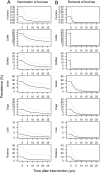Identifying host species driving transmission of schistosomiasis japonica, a multihost parasite system, in China
- PMID: 23798418
- PMCID: PMC3710859
- DOI: 10.1073/pnas.1221509110
Identifying host species driving transmission of schistosomiasis japonica, a multihost parasite system, in China
Abstract
Understanding disease transmission dynamics in multihost parasite systems is a research priority for control and potential elimination of many infectious diseases. In China, despite decades of multifaceted control efforts against schistosomiasis, the indirectly transmitted helminth Schistosoma japonicum remains endemic, partly because of the presence of zoonotic reservoirs. We used mathematical modeling and conceptual frameworks of multihost transmission ecology to assess the relative importance of various definitive host species for S. japonicum transmission in contrasting hilly and marshland areas of China. We examine whether directing control interventions against zoonotic reservoirs could further reduce incidence of infection in humans or even eliminate transmission. Results suggest that, under current control programs, infections in humans result from spillover of transmission among zoonotic reservoirs. Estimates of the basic reproduction number within each species suggest that bovines (water buffalo and cattle) maintained transmission in the marshland area and that the recent removal of bovines from this area could achieve local elimination of transmission. However, the sole use of antifecundity S. japonicum vaccines for bovines, at least at current efficacies, may not achieve elimination in areas of comparable endemicity where removal of bovines is not a feasible option. The results also suggest that rodents drive transmission in the hilly area. Therefore, although targeting bovines could further reduce and potentially interrupt transmission in marshland regions of China, elimination of S. japonicum could prove more challenging in areas where rodents might maintain transmission. In conclusion, we show how mathematical modeling can give important insights into multihost transmission of indirectly transmitted pathogens.
Conflict of interest statement
The authors declare no conflict of interest.
Figures



References
Publication types
MeSH terms
Grants and funding
LinkOut - more resources
Full Text Sources
Other Literature Sources

